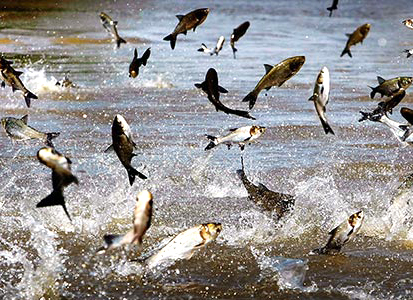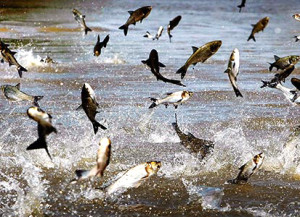The Recorder
MANITOULIN—A Great Lakes-Mississippi River separation to block Asian carp from the Great Lakes is possible, practical and preventive, say representatives of Great Lakes United (GLU).
“The Great Lakes United (GLU) group certainly thinks the study (released by the Great Lakes Commission and Great Lakes-St. Lawrence Cities Initiatives) proposing the Great-Lakes Mississippi River separation (and hence providing Canadian waters being protected from Asian carp invasion) is positive,” stated Mike Wilton, a Manitouliin resident and member of GLU, when contacted by the Recorder last week. “It looks as if it probably would protect Canadian waters from Asian carp.”
The much-anticipated study says separating the Great Lakes and Mississippi River basins to prevent the spread of Asian carp and other invasive species is not only possible, but a natural step toward much-needed action to improve Chicago’s water infrastructure.
Great Lakes environmental groups reacting to the study, which was released last week, commended the author’s factual analysis concluding that separation is possible and that it must include essential upgrades to sewage, flood control and waterborne transportation while preventing the transfer of invasive species.
“The study is unprecedented in its scope and ambition,” said Jennifer Nalbone, director of navigation and invasive species for GLU. It points the way to a solution that not only benefits the Great Lakes states, but also Canadian and Mississippi River stakeholders. Most of North America will ecologically and economically benefit from separating the two basins.”
The study refocuses Canada and the US on a long-term permanent solution and away from stop gap measures that, on their own, will ultimately fail to stop the Asian carp’s march to Lake Michigan, and eventually to the Canadian Great Lakes, tributaries and inland waters, a GLU release states.
The bighead and silver carp are the poster fish for the ecological and economic havoc in the offing when invading species travel between the Great Lakes and Mississippi, the GLU says. A 2004 Department of Fisheries and Oceans risk assessment determined that Asian carp species will compete for food with native species, prey on their larvae, as well as potentially cause significant habitat damage and ecological disruption. They may be able to establish in Canadian waters as far north as Hudson Bay.
Since 2009, multiple hits of Asian carp DNA have been found lake ward of an electric barrier in the Chicago Waterway System meant to keep the fish out of Lake Michigan and the Great Lakes. More recently, carp DNA has been reported in waters open to Lake Michigan.
“Asian carp are a huge threat, which can only be effectively addressed by preventing the fish from entering Lake Michigan where they would be free to enter Canadian waters,” said Elaine MacDonald, senior scientist from Ecojustice. “Separating the two basins in the Chicago area is the permanent solution to this tremendous international problem.”
The authors note that restoring the natural divide between the Great Lakes and Mississippi River basins at Chicago can coordinate with efforts already under way by the city of Chicago, the state of Illinois and the Metropolitan Water Reclamation District to improve water quality and reduce flooding.
The study proposes three options to separate the Great Lakes from the Mississippi River basin near Chicago and keep Asian carp and other invaders out, but all three involve re-reversing the flow of Chicago River, which now carries Chicago’s treated waste water away from its Lake Michigan drinking water.
“Physically separating the Great Lakes and Mississippi River watersheds is the best long-term solution for preventing the movement of Asian carp and other aquatic invasive species, and our report demonstrates that it can be done,” said Tim Eder, executive director of the Great Lakes Commission, and sponsor of the study with several other interest groups, in a release.
The prolific Asian carp have populated the Mississippi River and many of its tributaries and now threatens the $7 billion fishery in the lakes, which contain one-fifth of the world’s fresh surface water and supply 35 million people with drinking water.
The invasions by silver and bighead carp, first introduced to control algae in commercial fish ponds, have prompted promotional efforts to catch them as a source of cheap protein or for sport fishing, but their populations have exploded.
The US Army Corps of Engineers, which is conducting its own long-term study on possible separation of the watersheds that is due to be completed in 2015, has erected electric underwater barriers at a canal bottle-neck near Chicago to try to keep the carp at bay, but some marine experts fear the carp may have already bypassed the barriers.
Several states bordering the lakes have demanded stronger action and have filed a lawsuit against the Army Corps, calling for quick action to erect separation barriers and speed up its study.
The Commission’s 18 month long study estimated the total cost of erecting barriers to achieve ecological separation and measures to address water quality, flood prevention and alternative transportation at up to $9.5 billon
The least costly option would cost between $3.3-$4.3 billion and involve erecting four barriers including one near the existing O’Brien Lock near Lake Calumet. At that point, cargo could be transferred between river barges and trains, trucks, or lake going boats. A second barrier on the Chicago River could be equipped with a system to lift and transfer recreational boats from one side to the other.
Another option would be to place five barriers in waterways closer to Lake Michigan, and a third would place a barrier further downstream. Both pose significant transportation and flood management challenges, raising the cost to more than $9.5 billion, the study said.
The study projected a two-phase implementation of the plans with an initial target to erect barriers by 2022. Flood protection depends in part on completion by 2020 of a $3.7 billion system of tunnels and reservoirs designed to divert the Chicago area’s storm water, a project begun in the early 1970s.
Joel Brammeier, president and CEO of the Alliance for the Great Lakes, says the study is the most specific evaluation to date of what it would take to achieve hydrological separation of the CAWS. “Chicago and Illinois have been under a spotlight as the carp close in on Lake Michigan. This report shines that light in a new direction; toward the transformation of the Chicago waterway into a resource of which everyone in the city, the state and the country can be proud.”
He said the GLC-GLSLCI study clearly demonstrates that separation is possible, providing detailed background on three separation options that allow elected officials and community leaders to move the discussion to the next level. As any separation is intrinsically tied to the multiple uses of the waterway system, it is imperative the Chicago region be an engaged partner.
To that end, the groups stress that the study is a beginning, not an end, and should not be interpreted as a strict set of policy recommendations. Until separation is complete, they say strong interim protections must be implemented to protect against an Asian carp invasion, and note that the study includes such measures within its long-term vision for separation.
The groups say a plodding US Army Corps of Engineers study of the problem, the Great Lakes and Mississippi River Interbasin Study, could be expedited by incorporating findings from the GLC-GLSLCI study and beginning separation planning now.
“Canada’s Department of Fisheries and Oceans completed an Asian carp risk assessment in 2004 and found these voracious silver and bighead carp that spawn several times a year will invade nearly all of the Canadian Great Lakes shorelines and then travel up our rivers to get into our lakes. The Great Lakes are bi-national waters and we do not want these invasive carp in our waters,” said Mary Muter, chair of the Great Lakes Section of the Sierra Club-Ontario. “This report shows that we should get construction started soon rather than wait another five years for the USACE to study the problem. The time to act is now!”
“It seems feasible and now it is up to both governments to provide the financial support needed to get this project done,” said Mr. Wilton.





